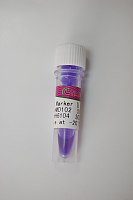Screening for DNA Heteroduplexes in the Factor VII Gene Using Ethylene Glycol Gel Electrophoresis of Solvent-Treated 32P-Labeled PCR Products
互联网
308
Sequencing exon by exon to identify mutations is both laborious and time consuming. Screening techniques have been sought to identify mutations without the need for this. Rapid detection of single base changes have focused on identification of the heteroduplex formed when wild-type and mutant come together (1 –3 ). Enzymes have been employed to cleave the heteroduplex at the mismatch site, but this obviously needs the bases to be known prior to commencement (1 ). A second option is to detect the change by monitoring the affect on melting temperature of the double-stranded DNA and its subsequent migration during denaturing gel electrophoresis (2 ). Third, chemicals can be employed that bind to the mismatch site, allowing immunochemical labeling of the products for identification (3 ). All these techniques have their limitations and no one method will detect all mutations (4 –6 ).









